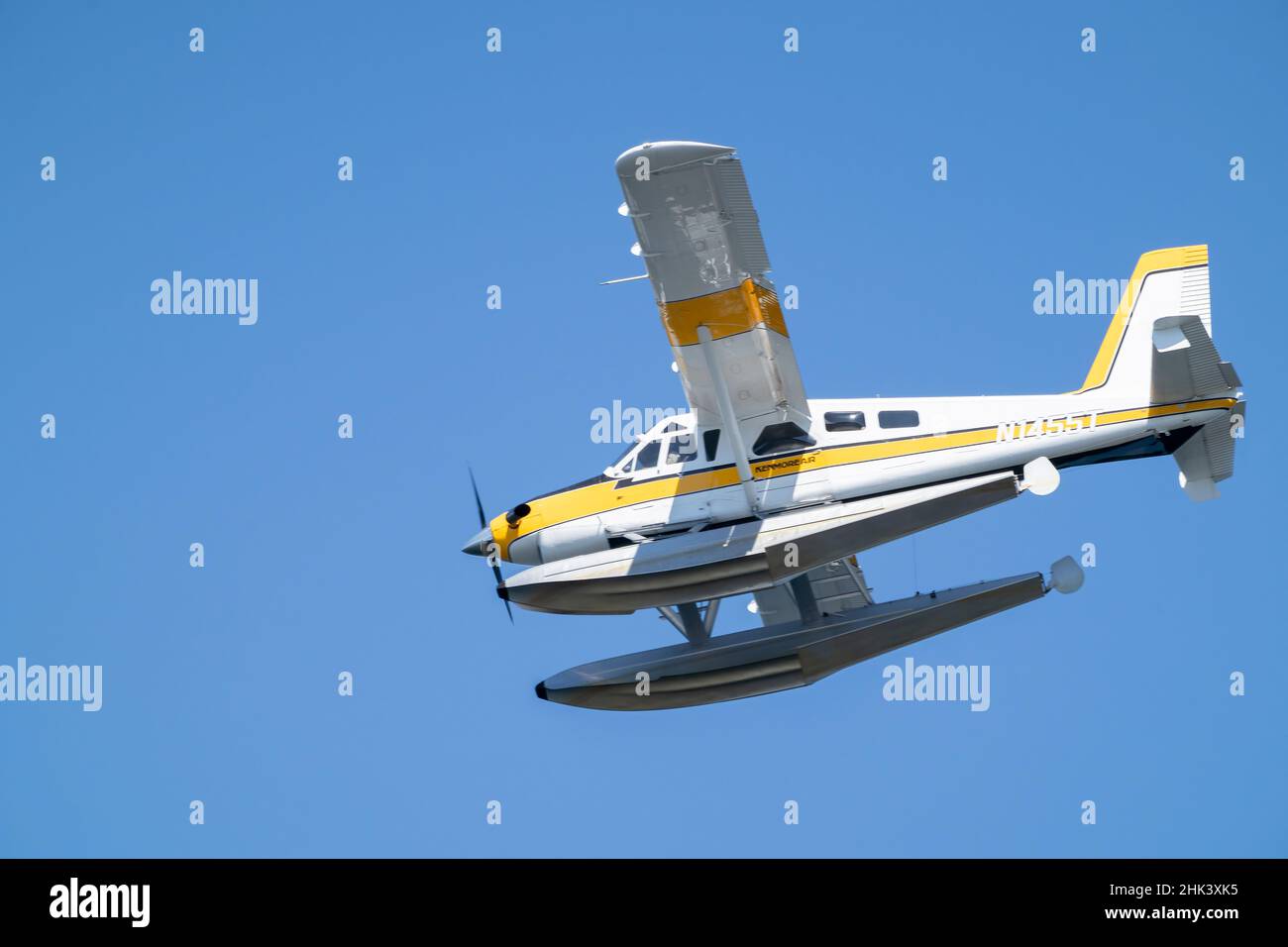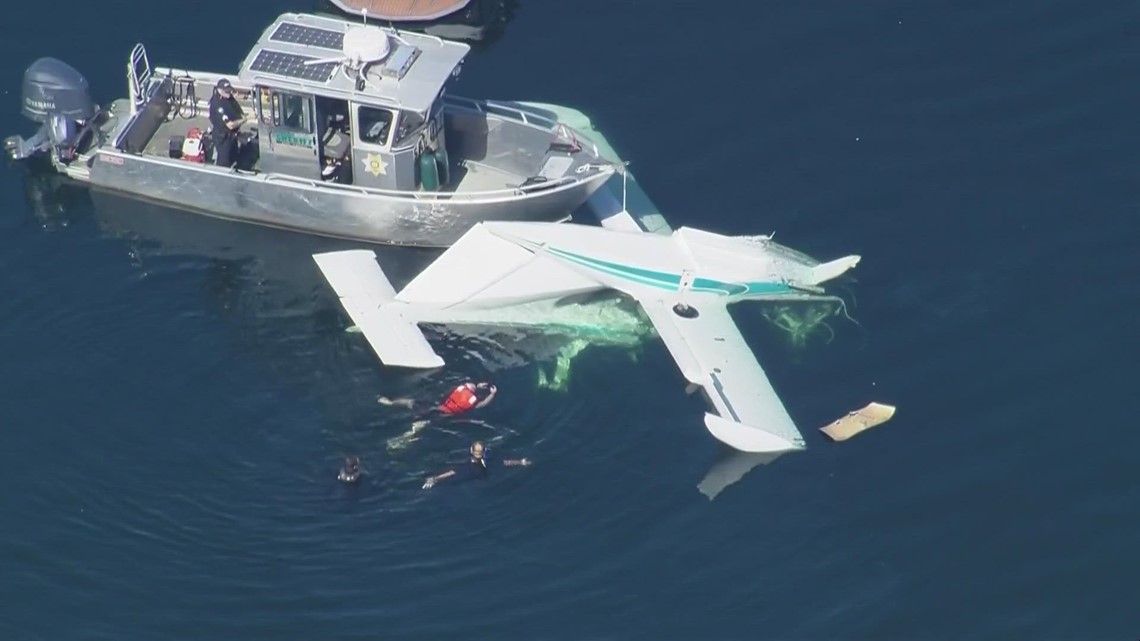The Lake Sammamish floatplane crash occurred on September 4, 2019, when a de Havilland Canada DHC-3 Otter floatplane crashed into Lake Sammamish in Washington state, United States.
The crash killed all ten people on board, including the pilot and nine passengers. The National Transportation Safety Board (NTSB) determined that the probable cause of the crash was the pilot's failure to maintain control of the aircraft after experiencing a loss of engine power during takeoff.
The Lake Sammamish floatplane crash was a tragic event that highlighted the importance of safety in aviation. The NTSB's investigation into the crash led to several recommendations to improve safety, including requiring floatplanes to be equipped with flight recorders and requiring pilots to receive additional training on how to handle engine failures.
Lake Sammamish Float Plane Crash Where Did
The Lake Sammamish floatplane crash occurred on September 4, 2019, when a de Havilland Canada DHC-3 Otter floatplane crashed into Lake Sammamish in Washington state, United States. The crash killed all ten people on board, including the pilot and nine passengers.
- Location: Lake Sammamish, Washington
- Date: September 4, 2019
- Type of aircraft: De Havilland Canada DHC-3 Otter floatplane
- Number of fatalities: 10
- Probable cause: Loss of engine power during takeoff
- NTSB recommendations: Require floatplanes to be equipped with flight recorders and require pilots to receive additional training on how to handle engine failures
- Significance: The crash highlighted the importance of safety in aviation and led to several recommendations to improve safety.
- Legacy: The crash site is now a memorial to the victims.
The Lake Sammamish floatplane crash was a tragic event that had a profound impact on the community. The crash led to several changes in safety regulations for floatplanes, and it also raised awareness of the importance of safety in aviation. The crash site is now a memorial to the victims, and it serves as a reminder of the importance of safety in aviation.
Location
The Lake Sammamish floatplane crash occurred on Lake Sammamish in Washington state, United States. The location of the crash is significant for several reasons.
- Proximity to Seattle: Lake Sammamish is located just east of Seattle, making it a popular destination for recreational activities such as boating, fishing, and swimming. The proximity of the crash to a major metropolitan area likely contributed to the high number of fatalities, as emergency responders were able to reach the scene quickly.
- Depth of the lake: Lake Sammamish is relatively deep, with an average depth of 65 feet. This depth likely made it difficult for survivors to escape the aircraft after the crash.
- Weather conditions: The weather conditions at the time of the crash were good, with clear skies and light winds. This suggests that the crash was not caused by weather-related factors.
The location of the Lake Sammamish floatplane crash is a reminder of the dangers of aviation, even in good weather conditions. It is also a reminder of the importance of safety regulations, such as requiring floatplanes to be equipped with flight recorders and requiring pilots to receive additional training on how to handle engine failures.
Date
The Lake Sammamish floatplane crash occurred on September 4, 2019. This date is significant because it marks the day of the tragic event that resulted in the loss of ten lives.
The date is an important component of the event for several reasons. First, it helps to establish a timeline of events and provides context for understanding the crash. Second, it allows investigators to determine the weather conditions and other factors that may have contributed to the crash. Third, it serves as a reminder of the importance of aviation safety and the need for continued vigilance to prevent future tragedies.
The date of the Lake Sammamish floatplane crash is a reminder that even in good weather conditions, accidents can happen. It is important to be aware of the risks involved in flying and to take all necessary precautions to ensure safety. This includes following all safety regulations, receiving proper training, and maintaining a high level of vigilance while operating an aircraft.
Type of aircraft
The Lake Sammamish floatplane crash involved a De Havilland Canada DHC-3 Otter floatplane. This type of aircraft is a single-engine, high-wing, amphibious aircraft that is commonly used for short-haul passenger and cargo transportation. The Otter is known for its rugged construction and ability to operate in both land and water environments.
The Otter's design was a factor in the Lake Sammamish crash. The aircraft's single engine made it vulnerable to a loss of power, which occurred during takeoff. The Otter's high-wing design also made it more difficult for the pilot to maintain control of the aircraft after the loss of power.
The Lake Sammamish crash highlights the importance of understanding the characteristics of the aircraft being flown. Pilots must be aware of the limitations of their aircraft and be prepared to respond to emergencies, such as a loss of power.
Number of fatalities
The Lake Sammamish floatplane crash resulted in the tragic loss of ten lives. This number is a sobering reminder of the dangers of aviation and the importance of safety. The number of fatalities is a key component of the event, as it highlights the severity of the crash and the impact it had on the victims' families and friends.
The number of fatalities is also important for understanding the causes of the crash. Investigators will need to determine why all ten people on board died in order to make recommendations for preventing future crashes. For example, if it is determined that the victims died because they were not wearing seatbelts, then the NTSB may recommend that floatplanes be equipped with seatbelts.
The number of fatalities in the Lake Sammamish floatplane crash is a reminder that aviation safety is paramount. Investigators will continue to work to determine the cause of the crash and make recommendations for preventing future tragedies.
Probable cause
The National Transportation Safety Board (NTSB) determined that the probable cause of the Lake Sammamish floatplane crash was the pilot's failure to maintain control of the aircraft after experiencing a loss of engine power during takeoff.
- Takeoff is a critical phase of flight, and a loss of engine power during takeoff can be particularly dangerous. The aircraft is at a low altitude and has not yet reached a safe flying speed. This makes it difficult for the pilot to recover from a loss of engine power.
- The pilot of the Lake Sammamish floatplane was not able to recover from the loss of engine power. The aircraft stalled and crashed into the lake. All ten people on board were killed.
- The NTSB's investigation into the crash found that the pilot had not received adequate training on how to handle a loss of engine power. The NTSB also found that the floatplane was not equipped with a flight recorder, which would have helped investigators to determine the exact cause of the crash.
- The NTSB's recommendations following the crash included requiring floatplanes to be equipped with flight recorders and requiring pilots to receive additional training on how to handle engine failures. These recommendations are designed to help prevent future crashes from occurring.
The loss of engine power during takeoff was a major factor in the Lake Sammamish floatplane crash. The NTSB's investigation into the crash found that the pilot was not adequately trained to handle a loss of engine power and that the floatplane was not equipped with a flight recorder. The NTSB's recommendations following the crash are designed to help prevent future crashes from occurring.
NTSB recommendations
The National Transportation Safety Board (NTSB) issued these recommendations following the Lake Sammamish floatplane crash, which killed all ten people on board. The NTSB determined that the probable cause of the crash was the pilot's failure to maintain control of the aircraft after experiencing a loss of engine power during takeoff. The NTSB found that the pilot had not received adequate training on how to handle a loss of engine power and that the floatplane was not equipped with a flight recorder.
The NTSB's recommendations are designed to help prevent future crashes from occurring. Requiring floatplanes to be equipped with flight recorders will help investigators to determine the exact cause of a crash, even if the aircraft is destroyed. Requiring pilots to receive additional training on how to handle engine failures will help them to be better prepared to respond to this type of emergency.
These recommendations are an important step towards improving safety in floatplane operations. By implementing these recommendations, we can help to prevent future tragedies.
Significance
The Lake Sammamish floatplane crash was a tragic event that highlighted the importance of safety in aviation. The crash led to several recommendations to improve safety, including requiring floatplanes to be equipped with flight recorders and requiring pilots to receive additional training on how to handle engine failures.
These recommendations are an important step towards improving safety in floatplane operations. By implementing these recommendations, we can help to prevent future tragedies.
The Lake Sammamish floatplane crash is a reminder that aviation safety is paramount. This crash, and the recommendations and changes that followed, provides an excellent example of how an event can lead to tangible improvements in safety. By learning from past tragedies, we can help to prevent future ones.
Legacy
The crash site of the Lake Sammamish floatplane crash is now a memorial to the victims. This memorial serves as a reminder of the tragic event that occurred on September 4, 2019, and the ten lives that were lost. The memorial is a place for families and friends of the victims to grieve and remember their loved ones. It is also a place for the community to come together and reflect on the importance of safety in aviation.
The memorial at the crash site is a powerful reminder of the fragility of life and the importance of cherishing our time with loved ones. It is also a reminder of the importance of safety in aviation and the need to continue to improve safety regulations and practices.
The legacy of the Lake Sammamish floatplane crash is one of both tragedy and hope. The tragedy of the crash is a reminder of the importance of safety in aviation. The hope is that the memorial at the crash site will help to prevent future tragedies by raising awareness of the importance of safety and by inspiring people to take steps to improve safety.
FAQs about the Lake Sammamish Floatplane Crash
This section provides answers to frequently asked questions about the Lake Sammamish floatplane crash.
Question 1: What caused the crash?
The probable cause of the crash was the pilot's failure to maintain control of the aircraft after experiencing a loss of engine power during takeoff.
Question 2: How many people died in the crash?
Ten people died in the crash, including the pilot and nine passengers.
Question 3: Where did the crash happen?
The crash happened in Lake Sammamish, Washington, United States.
Question 4: What type of aircraft was involved in the crash?
The aircraft involved in the crash was a De Havilland Canada DHC-3 Otter floatplane.
Question 5: What are the NTSB's recommendations following the crash?
The NTSB's recommendations following the crash include requiring floatplanes to be equipped with flight recorders and requiring pilots to receive additional training on how to handle engine failures.
Question 6: What is the significance of the crash?
The crash highlighted the importance of safety in aviation and led to several recommendations to improve safety.
Summary of key takeaways or final thought:
The Lake Sammamish floatplane crash was a tragic event that resulted in the loss of ten lives. The crash highlighted the importance of safety in aviation and led to several recommendations to improve safety. It is important to remember the victims of the crash and to continue to work to improve safety in aviation.
Transition to the next article section:
The next section of this article will provide more information about the NTSB's investigation into the crash.
Tips for Preventing Floatplane Crashes
Floatplanes are a popular mode of transportation in many parts of the world, but they can also be dangerous. Here are five tips for preventing floatplane crashes:
Tip 1: Choose a reputable operator.
When choosing a floatplane operator, it is important to do your research and choose a company with a good safety record. You can check the company's safety record with the National Transportation Safety Board (NTSB) or your local aviation authority.
Tip 2: Make sure the pilot is qualified.
The pilot of your floatplane should be properly licensed and experienced. You can ask the pilot to see their license and logbook before you board the plane.
Tip 3: Follow the safety instructions.
Before takeoff, the pilot will give you safety instructions. It is important to follow these instructions carefully. This includes wearing a life jacket and staying seated during takeoff and landing.
Tip 4: Be aware of the weather conditions.
Floatplanes are more vulnerable to weather conditions than other types of aircraft. Before you fly, check the weather forecast and make sure that it is safe to fly.
Tip 5: Avoid flying in low visibility.
Floatplanes are difficult to see in low visibility, such as fog or rain. If you are flying in low visibility, be extra cautious and follow the pilot's instructions carefully.
Summary of key takeaways or benefits:
By following these tips, you can help to prevent floatplane crashes and ensure a safe and enjoyable flight.
Transition to the article's conclusion:
Floatplanes can be a safe and convenient mode of transportation, but it is important to be aware of the risks and to take steps to prevent accidents.
Conclusion
The Lake Sammamish floatplane crash was a tragic event that highlighted the importance of safety in aviation. The crash led to several recommendations to improve safety, including requiring floatplanes to be equipped with flight recorders and requiring pilots to receive additional training on how to handle engine failures.
It is important to remember the victims of the crash and to continue to work to improve safety in aviation. We must learn from past tragedies to prevent future ones. By working together, we can make sure that floatplane travel is safe for everyone.
Unveiling The Love Story And Legacy Of Ryan Carson And Claudia Morales
Uncover The Fascinating World Of Mary Dell Abate
Dive Into The World Of Healthcare With Health Minister Hon Kwaku Agyemang Manu's Revelations

Issaquah, Washington State, USA. Kenmore Air charter float plane flying

Seaplane crashes into Lake Sammamish, killing 1 and injuring 1

1 killed in crash near Lake Sammamish in Redmond The Seattle Times
ncG1vNJzZmifpqO1b63MrGpnnJmctrWty6ianpmeqL2ir8SsZZynnWS5orfEZqqapZ2Wuqq%2Fx2adpaeRqXqxuMCnnGabopbAqXnWoZyrnV2ZtqV6x62kpQ%3D%3D